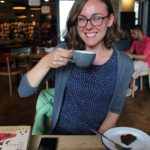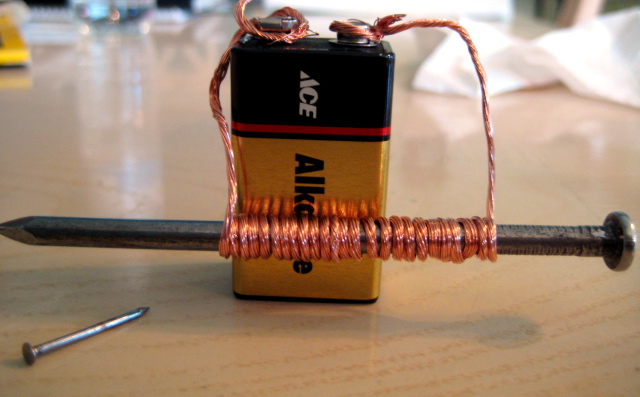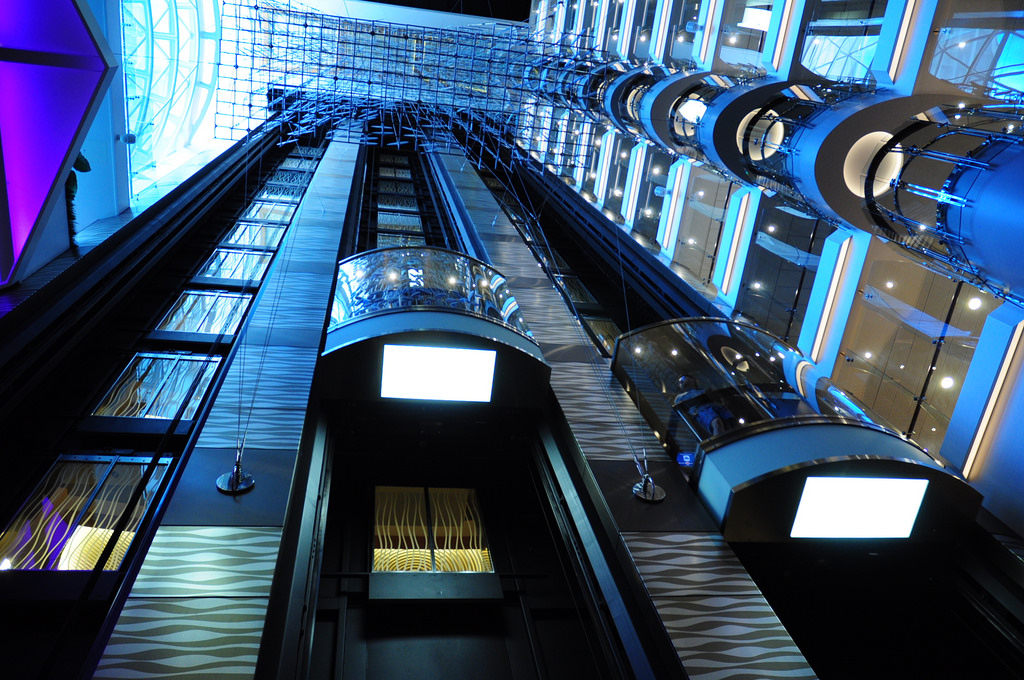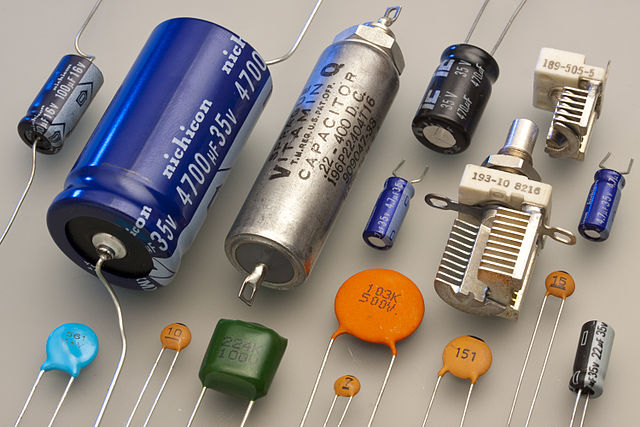Step 1
Cut out a piece of cardstock which is 10 cm by 10 cm. In the following steps, make reference to the template
Step 2
Using a ruler, draw two diagonal lines from corner to corner of the square.
Step 3
On each line, make a mark 2 cm from the centre of the square.
Step 4
Cut the card along the lines, cutting from the corners towards the centre of the square. Stop cutting then the scissors reach the 2 cm markings.
Step 5
Locate the corners marked with circles in the template. Fold these corners and attach each one to the centre of the square using staples. Ensure that the staples are placed very close to the centre of the square. You have created the four turbine blades of the pinwheel.
Step 6
Pass the motor shaft through the layers of cardstock at the centre of the pinwheel. Scissors may need to be used to make a small incision in the cardstock.
Step 7
Secure the pinwheel in place using the small cap which was attached to the motor shaft. If this cap is missing, use a small piece or cork or clay.
Step 8
Connect the LED to the motor supply terminals. The leads of the LED could be directly inserted into the supply terminals, or the wires could be used to create the connections.
Step 9
Turn the cup upside down. Use the hot glue to attach two ice cream sticks to the sides of the cup, opposite each other. Make sure that the ends of the sticks extend above the bottom of the cup. Try to align the sticks so that they are at the same height.
Step 10
Use the hot glue to attach the motor between the ends of the sticks.
Step 11
Turn on the fan. Holding the cup, place the turbine model in front of the fan and observe what happens. What happens if the pinwheel is rotated in the opposite direction?
- Brown tape could be used instead of hot glue. However, the structure would be less stable.
- The motor could be salvaged from an old toy, as long as the specifications are similar to those mentioned in ‘Materials Required’.
- The hot glue gun should be used with the help of an adult and under strict supervision since hot glue is a burn risk. Younger children should not be allowed to operate the device.
- Use adequate protection to prevent the work surface from being damaged by the hot glue.
- Handle scissors with care. Place on a table when not in use.
- Take care when punching the cardstock. Keep your hands and face away from the path of the motor shaft.
Have you ever held an umbrella on a windy day? Sometimes it feels as though the wind is trying to snatch away anything you have in your hands.
Wind is so powerful because it carries a lot of energy. That’s why engineers are trying to capture the energy in the wind and convert it into electricity which we can use to power our homes. For this they use wind turbines.
The wind has enough enough energy to turn the blades of huge wind turbines. Because they are moving, the blades have kinetic energy. As the wind turns the turbine blades, the turbine rotates the shaft of the generator. The shaft triggers a special process in the generator which generates electricity. This energy travels out of the turbine as current and voltage.
Therefore, the generator converts the kinetic energy in the blades into electrical energy, which we can ‘see’ when the LED switches on.
Why does the LED light up?
Generator outputs a current.
How does the generator change transform energy?
The shaft turns a wire in a magnetic field, producing electricity.
Why does the LED sometimes light up and sometimes remain dark?
LEDs are polarized devices.
Why are wind turbines found in groups (farms)?
Need many turbines to power the grid.
Do wind farms affect the weather?
Local day temperatures are cooler, at night they are warmer.
What problems do you think wind turbines create?
Noise, visual pollution, danger to birds.
The toy motor can be operated in two modes:
Motor mode: A battery is connected to the supply terminals and the motor shaft spins. Electrical energy (from the battery) is converted to kinetic energy in the rotating shaft. Generator mode: The shaft is rotated and a voltage is developed across the supply terminals. The energy transformation is opposite to motor mode. This mode of operation was used in the experiment.
The airflow from the fan exerts a force on the pinwheel, causing it to spin. Some of the kinetic energy in the air particles is transformed into kinetic energy in the spinning pinwheel. The pinwheel is directly connected to the shaft of the generator, such that as the pinwheel begins to spin, so does the generator shaft.
The generator converts the kinetic energy of the rotating shaft to electrical energy which powers the LED. (Video). The rotating shaft causes a voltage to develop across the supply terminals, which causes a current to flow through the LED, making it light up.
The LED only lights up when the motor is spun in a particular direction. Changing the direction of rotation causes a voltage with an opposite polarity to be developed across the supply terminals (the plus and minus of the voltage are swapped). The LED is a polarized device, meaning it will only light up when the voltage is in a certain direction.
The DC toy motor was operated in generator mode. It converts mechanical energy into electrical energy by Faraday’s Law of Electromagnetic Induction. When a conductor moves within a magnetic field, electrons within the conductor tend to move perpendicular to the magnetic field. This generates an electromotive force (EMF) across the conductor, resulting in a flow of electrons in the direction of the EMF. This results in a current flow out of the generator and through the load, which in this case is the LED.
The conductor wire is wound round a rotating armature to create the rotor of the motor. The rotor rotates with the shaft. Fixed magnets in the stator produce the magnetic field. The stator is stationary. The rotation of the coil results in variation in the magnetic flux coupled with the wound conductor. This leads to the development of a DC voltage and current. Thus, the mechanical energy in the shaft is converted to electrical energy, which manifests itself as a DC voltage and current.
An LED is a current-controlled device. This means that the intensity of the light is directly proportional to the current flow through the LED. The figure below is a labelled diagram of an LED.

In order for the LED to conduct current and thus light up (forward bias operation), the anode terminal must be at a higher potential than the cathode terminal. Applying a reversed voltage polarity sends the LED into reverse bias operation. In this mode it blocks current flow and thus does not light up.
Applications
Some places have better conditions for wind farms than others. Usually, the average wind speed 50 m over the ground has to be at least 25 km/hour. Wind turbines are helping many countries cut carbon emissions in energy generation. However, their environmental impact is debated.
Onshore wind farms are built on land. They are the most cost-effective type of farm. They must be carefully situated because they are noisy, can be a hazard to birds, and cause visual pollution. Offshore wind turbines are thus gaining popularity. Near the shore, the turbines’ supports reach down into the seabed, which can affect benthic communities. Further out to sea, the turbines are placed on floating platforms. Deep offshore wind farms are situated far enough out at sea so as not to be visible from the coast. Offshore farms are more expensive to build than onshore farms and may still affect the surrounding environment.
Experts suggest pairing wind energy generation, which is very effective, with other renewable generation methods, such as solar panels.
Research
By 2020, the European Commission plans for 20% of of power to be sourced from onshore wind farms. Recent research has been focused on bringing wind turbines into urban and rurban areas, where there is promising market potential. This requires the development, construction and testing of new small wind turbines. Research aims to reduce maintenance costs, increase performance and decrease noise and vibrations in these turbines.
Wind turbine blades, generators and towers are exceedingly heavy, making them difficult and expensive to transport. Bladeless wind turbines are a possible solution. These lightweight, cylindrical structures oscillate in the wind. A generator converts the the kinetic energy into electricity. These structures do away with the heavy gears and bearings in traditional wind turbines.
- Vary the speed of the fan and observe how it affects the brightness of the LED.
- Remove the LED from the generator. Attach a 1.5V bulb in a bulb holder to the supply terminals using some insulated copper wire. Does the direction of motion of the pinwheel affect whether the bulb switches on or not?









